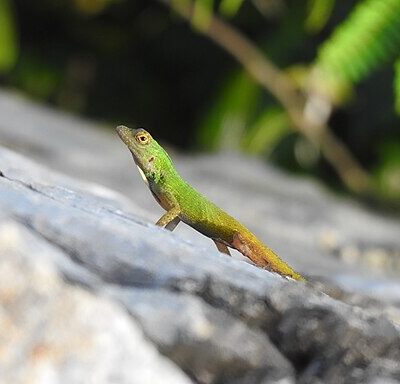2025 Stories
Antibiotic resistance lingers long after the meds are finished
If you are lucky enough to have had regular medical care in the United States, odds are good that, at some point, you’ve taken antibiotics. Maybe you had strep throat, pink eye, an infected cut, or another of the range of bacterial infections that antibiotics can stamp out. Or perhaps yours was one of the full 25% of antibiotic prescriptions inappropriately given to fight a viral infection. Either way, you likely took the course of medication within a couple weeks, got better, and moved on. But new research reveals that your normal gut bacteria may not have moved on as quickly …
Read more »The tale of a fateful trip: How iguanas populated Fiji
Tropical islands like Hawaii, Tahiti, and Fiji offer locals and tourists alike a range of enticements – lush foliage, balmy weather, and beaches galore. But for biologists, who view such places not just through tinted sunglasses, but also through the lens of evolution, these vacation destinations offer intriguing mysteries as well. Such islands were produced by volcanic activity, arising out of the ocean devoid of life. So each represents a compelling test case of evolution in action starting from scratch. How did the ancestors of the living things that inhabit these islands today get there in the first place? How did each newly arrived species change the environment for the next? How did they all evolve once they arrived? How did waves of human migration shape the evolutionary trajectories of these isolated ecosystems? Last month, biologists announced the results of a study that solves one of these mysteries: how iguanas arrived on Fiji.
Read more »Measles, mutation, and the steadfast MMR vaccine
Amidst and following growth in vaccine hesitancy, measles cases are on the rise again in the United States. A recent outbreak in Texas and New Mexico so far involves more than 140 cases, the majority among children and youth, and has caused the death of a child. One of the most contagious human diseases known, measles travels easily through the air, remains alive on surfaces for hours, and can be transmitted for many days before it causes symptoms. Someone with measles will infect 90% of the unprotected people with whom they come into contact, leading to explosive outbreaks if vaccination rates are low. So even though measles is only occasionally deadly – around 2 of every 1000 children infected will die from complications, a small but significant risk – outbreaks can be massive and cause many deaths, especially among the most vulnerable. An outbreak in 2018 killed 140,000 people around the world, mostly children under five. The bright spot here is that the two doses of the MMR (measles, mumps, and rubella) vaccine are safe and very effective at preventing both illness and transmission for life. Why is the MMR vaccine so steadfast, when our COVID and flu shots need regular updates? The answer is, of course, evolution…
Read more »Is bird flu the new COVID-19?
If you’ve scrolled past the political news lately, you may have noticed increasingly alarming stories about bird flu, a virus that mainly affects birds but can also infect humans and other animals. Outbreaks on farms have led to the preventative killing of more than a hundred million chickens, turkeys, and other farm birds, driving up the cost of eggs. The virus has also spread to dairy cows across the country. One in five samples of supermarket milk have evidence of deactivated virus, and infectious virus particles have been found in raw milk. Contaminated pet food has led to the death of cats, and zoo animals have died after contracting the virus, perhaps from wild birds that landed in their enclosures. Multiple U.S. farmworkers have been infected, likely through contact with farm animals, and the United States recently reported its first death associated with the virus. You may well be asking, is this COVID all over again? Are we on the precipice of the next pandemic? Here, we’ll use the lens of evolution to compare the virus responsible for COVID-19 to the virus behind bird flu.
Read more »2024 Stories
Mummified saber-toothed kitten discovered in Siberia
In 2020, prospectors hunting for ancient mammoth tusks in Siberia made a surprise discovery. The frozen clump of hair they noticed sticking out of a riverbank turned out to be a literal and figurative furball: a saber-toothed cat cub, desiccated and preserved in permafrost. Last month, scientists reported on their research on this first-of-its-kind specimen. The 37,000-year-old kitten mummy, complete with whiskers, fur, and claws, died when it was three weeks old. While the remains have not yet revealed how this individual cat died, they are providing insight into saber-toothed cats in general, including details that are hard to glean from bones alone. For example, the preserved kitten’s fur was dark brown, not spotted, as in many modern big cats, its neck was unusually thick and muscly, and its long upper lip might suggest that its famous canines would have been covered as an adult. Read on to learn more about the evolution of this charismatic group of mammals.
Read more »Mpox: What’s a clade got to do with it?
Viral evolution makes the news again (in its usual, cruel way) as mpox cases surge in Africa. The outbreak, centered in the Democratic Republic of the Congo (DRC), threatens to spill over to other continents, constituting a global health emergency according to the World Health Organization. In 2022, mpox began to spread widely for the first time outside of Africa, where the virus naturally infects animals and sometimes makes the jump to human hosts. Most people infected with mpox fully recover without treatment. Although the 2022 outbreak eventually spread to 116 countries, it killed only around 220 people. The viral strain behind the current outbreak, however, appears to be deadlier. The DRC has already reported more than 1000 deaths. The difference seems to come down to the evolutionary origins of the two viral strains.
Read more »One small step for ancient dinos, one long plane ride for modern humans
Last month scientists announced that they’d identified a close match for dinosaur tracks found in the rocks of northern Cameroon…in Brazil, almost 4000 miles across the Atlantic Ocean! The footprints are about 120 million years old and include tracks from theropods (relatives of Tyrannosaurus), ornithopods (relatives of Hadrosaurus), and sauropods (relatives of Apatosaurus). Both sets of tracks, made when dinosaurs traversed the muddy surfaces near ancient streams and lakes, are preserved in the same sorts of sediments. In fact, the African and South American tracks are so similar that scientists think that they represent two halves of the same path, along which dinosaurs dispersed. How could a walking route that began in Africa ever wind up in South America? A look at Earth’s geologic history provides the answer…and illustrates the nature of scientific theories like evolution.
Read more »Wildfires drive evolutionary change, but can California ecosystems keep up?
In recent decades, fires have increased in size and frequency throughout California. The most recent of these record-breaking wildfires, named Park Fire, is the fourth-largest recorded wildfire in the state’s history. Park Fire started in Bidwell Park in Chico, California, as the result of arson. So far, it has burned through over 429,000 acres, destroyed more than 600 structures and burned through protected ecosystems, like Bidwell Park, the Big Chico Creek Ecological Reserve, and over 113,000 acres of Lassen National Forest. Many factors contribute to California’s ever larger and more frequent fires, but two big ones are climate change – with its resultant dry spells and record-breaking temperatures – and shifts in fire management strategies. In the last century, fire suppression practices, as opposed to controlled burns, have become the norm. Smaller, more frequent controlled burns decrease excess vegetation, reducing a fire’s ability to spread, while strict fire suppression can lead to a build-up of vegetation, increasing the frequency of large-scale wildfires. Here we’ll see how fires can drive evolution, helping plants survive and thrive after fires – and how more frequent fires can make some of these fire-adapted traits a liability.
Read more »We live in the age of humans, but it’s not the Anthropocene … yet
While you’ve probably heard of the Triassic, Jurassic, and Cretaceous periods by way of their most charismatic animals, the dinosaurs, other units of geologic time are less well known. The Siderian Period, for example, rarely makes headlines because it is, by definition, old news – 2.5-billion-year-old news. However, discussions of geologic time recently sprang up in news feeds when geologists considered shaking things up and declaring the end of the Holocene Epoch, which we’ve been living in since the last Ice Age ended more than 11,000 years ago. The idea was to cap the Holocene by sectioning off a new unit of time called the Anthropocene – the age of humans. Here we’ll dig into the geologic time scale to see why it matters and what the idea of the Anthropocene Epoch is all about.
Read more »Measles: New outbreaks, old virus
In recent weeks, measles cases have popped up across the U.S in Ohio, Florida, Washington, Michigan, Indiana, Minnesota, and beyond. This highly contagious virus often leads to hospitalization and occasionally to serious complications and death, especially in children under five. While the vaccine is safe and effective, declining vaccination rates have left pockets of people vulnerable. Measles might sound like ancient history compared to COVID-19, mpox, Zika, and other outbreaks that have made headlines in recent years – but how long has measles really been around? Evolutionary biology has the answer.
Read more »Why species stay the same
The word evolution is nearly synonymous with change. One species diversifies into many. A disaster triggers a mass extinction among marine life. A microbe becomes resistant to our drugs. Each of these changes, large or small, is a classic example of evolution in action. But what about lack of change? Most of the species we observe around us today look about the same as they did in our grandparents’ time. And the fossil record includes many species that seem hardly to have changed at all for millions of years. How does this conspicuous stability square with evolutionary theory? New research supports one explanation.
Read more »










